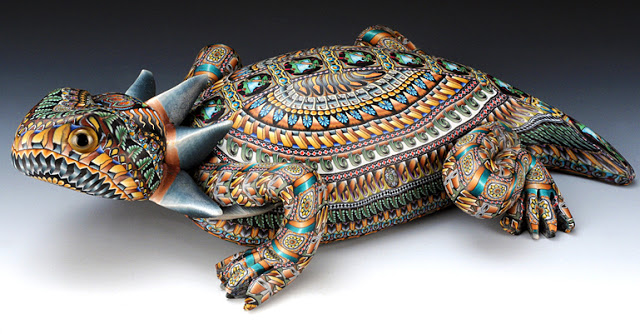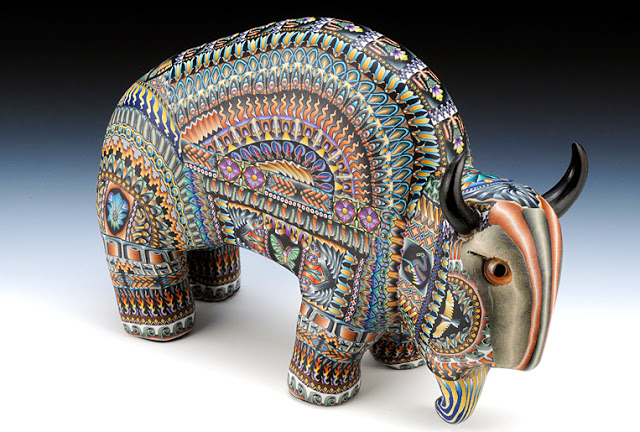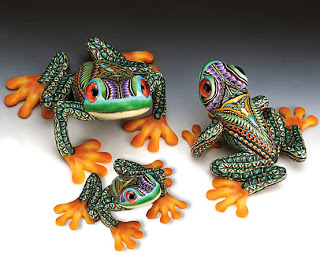Jon Anderson – Fimo Sculpture
Polymer clay modeling compounds were first introduced by
German dollmaker Kathe Kruse in the late 1930s as a possible replacement
for plastic compounds that were scarce from war privation. Although not
suitable for her doll factory use, she turned the formula over to her
daughter “Fifi” who sold the rights to Eberhard Faber in 1964 where it began to be marketed under the name “FIMO” (from Fifi’s Modeling Compound). By the 1950’s other manufacturers were making similar products, which were still primarily used for dolls and miniatures. But as it gained a wider audience it became available in toy stores, and in 1975 a German family began to import Fimo to the USA where it quickly gained a following of artists and crafts people. The compound has a consistency similar to plasticine, but its primary advantage is its ability to be hardened at low temperatures (110°C) allowing almost anyone to create permanent, solid artifacts.
Because of the wide range of available colors and styles (such as marbled and metallic versions), the media is particularly suited to the technique of caning (millefiori),
drawn from a traditional glass technique where a two dimensional design
is constructed by adding lengths of various colored strands into a single into a single form. Once the initial form (known as a “cane”) is completed it can be sliced to produce a number of nearly identical copies of the
design.
Born in Kingman, Arizona, Jon Anderson studied art at the Universidad de
las Americas and holds a master’s degree from Texas A & M
University. An accomplished painter, sculptor and jewelry designer, he has
lived among a diverse cross section cultures
from Central America to the Far East and his designs reflect the
influences from classical Moorish, Native American and Celtic motifs.
The patterns are created by hand; laying canes or blocks of different colors of clay next to each other and working outward, creating a
number of visual borders around the original image. Each of his canes is roughly the size of a large loaf of bread when first
constructed, then stretched and cut multiple times until the
final cross section is the size of a small coin. These small canes are
then thinly sliced into intricate tiles using a surgical scalpel.
The actual forms or armatures of the animals are created from hand-molded clay or carved wood: once the tiles have been
pressed onto the armature the piece is cured and then fired for a period of hours,
further reducing the images and tightening the spaces between the
individual tiles. This process may create crazing or tiny fissures in
the clay, which adds to the uniqueness of each piece. Finally the eyes
are carefully selected to give each sculpture its own personality. After cooling, the sculptures are meticulously
hand-sanded, making them very smooth and silky to the touch.
Because the animals are individually handmade, no two are ever
exactly alike. Once a particular cane is used that design is gone
forever.
Jon Anderson was featured in the 1995 book, “New Clay”, and his
work is available through select art galleries in North America.
fimocreations.com –(Main Site)
Pahaksa Tepee Gift Shop – (online sales)














Comments
Jon Anderson – Fimo Sculpture — No Comments
HTML tags allowed in your comment: <a href="" title=""> <abbr title=""> <acronym title=""> <b> <blockquote cite=""> <cite> <code> <del datetime=""> <em> <i> <q cite=""> <s> <strike> <strong>